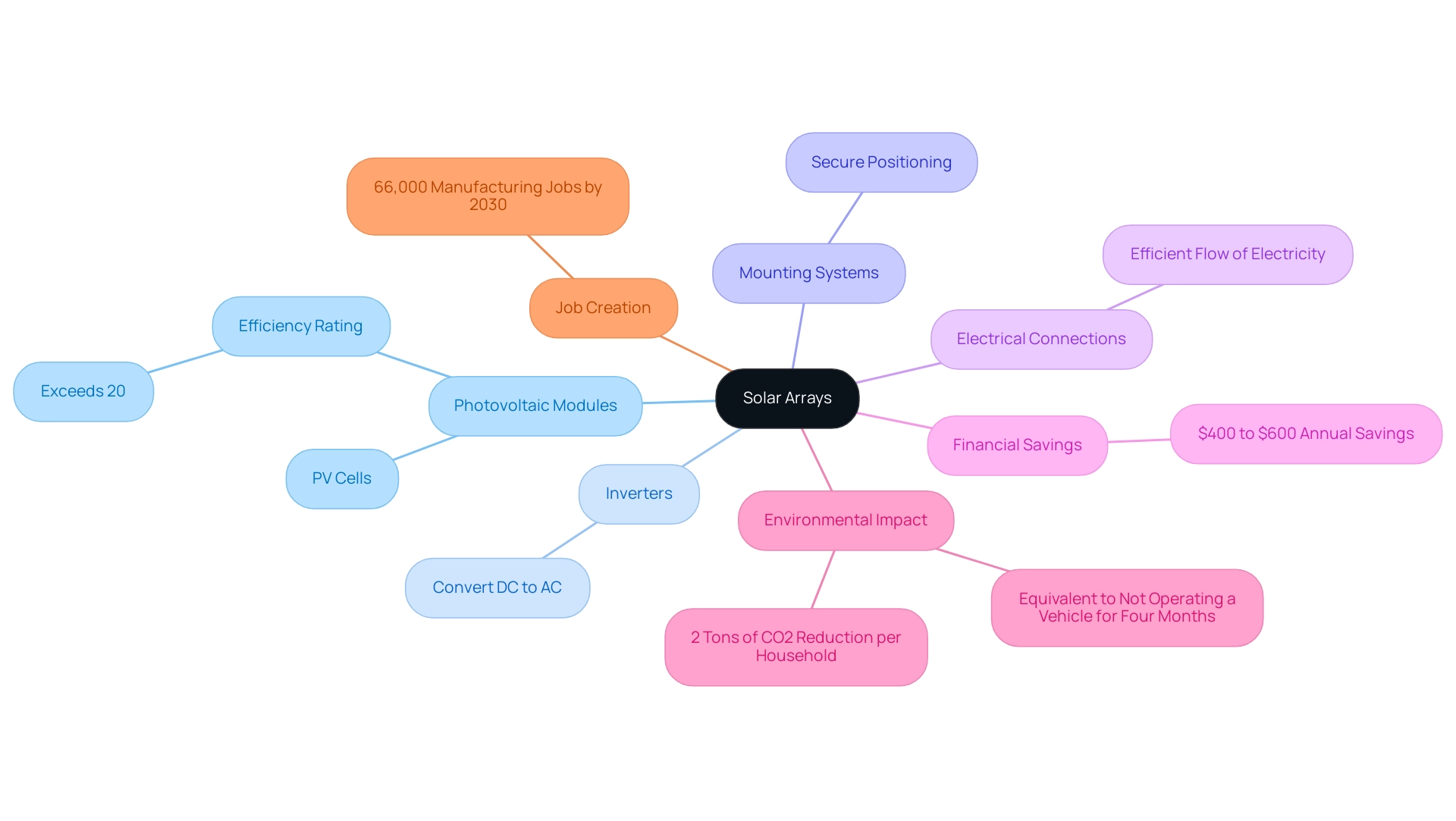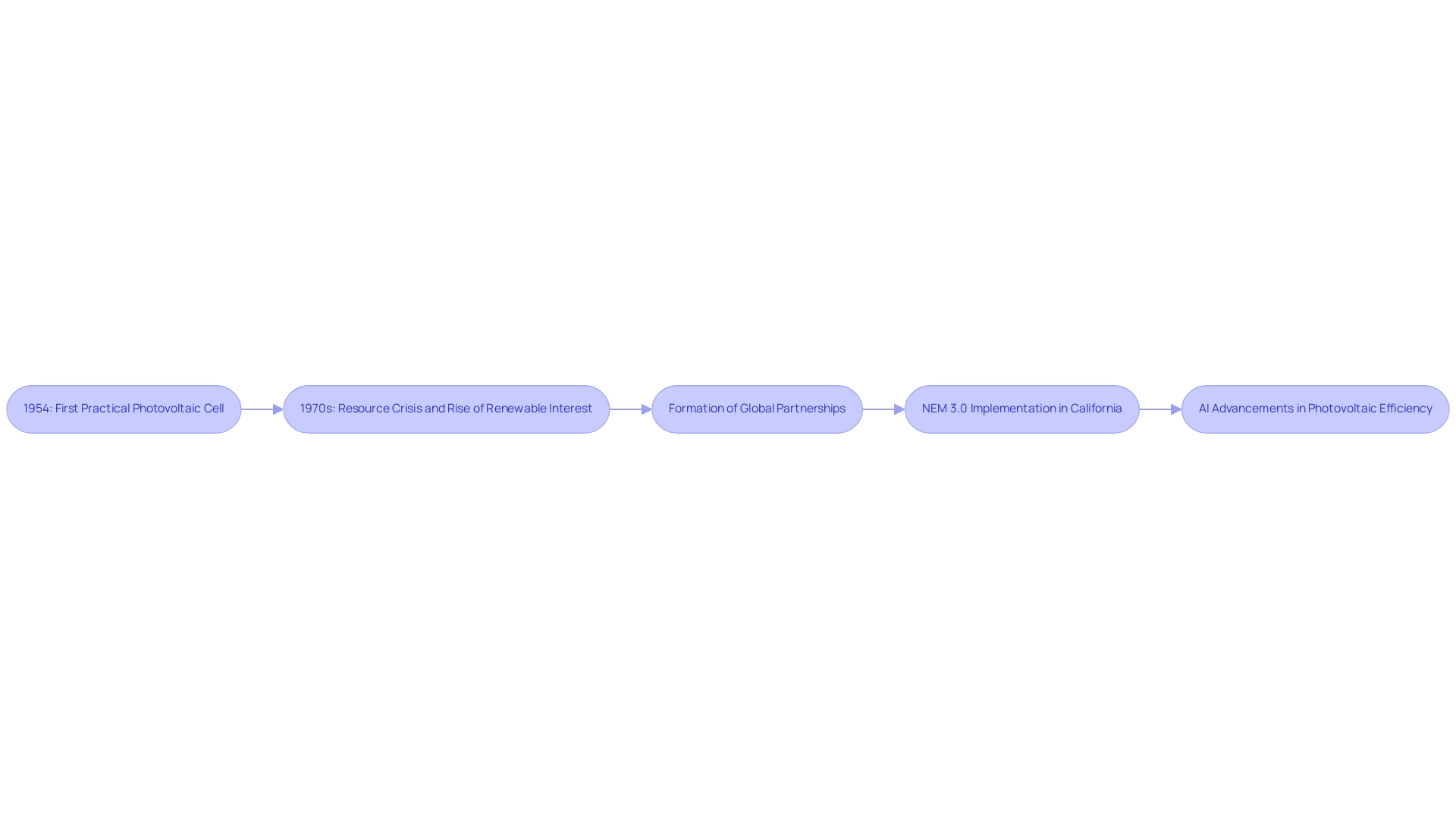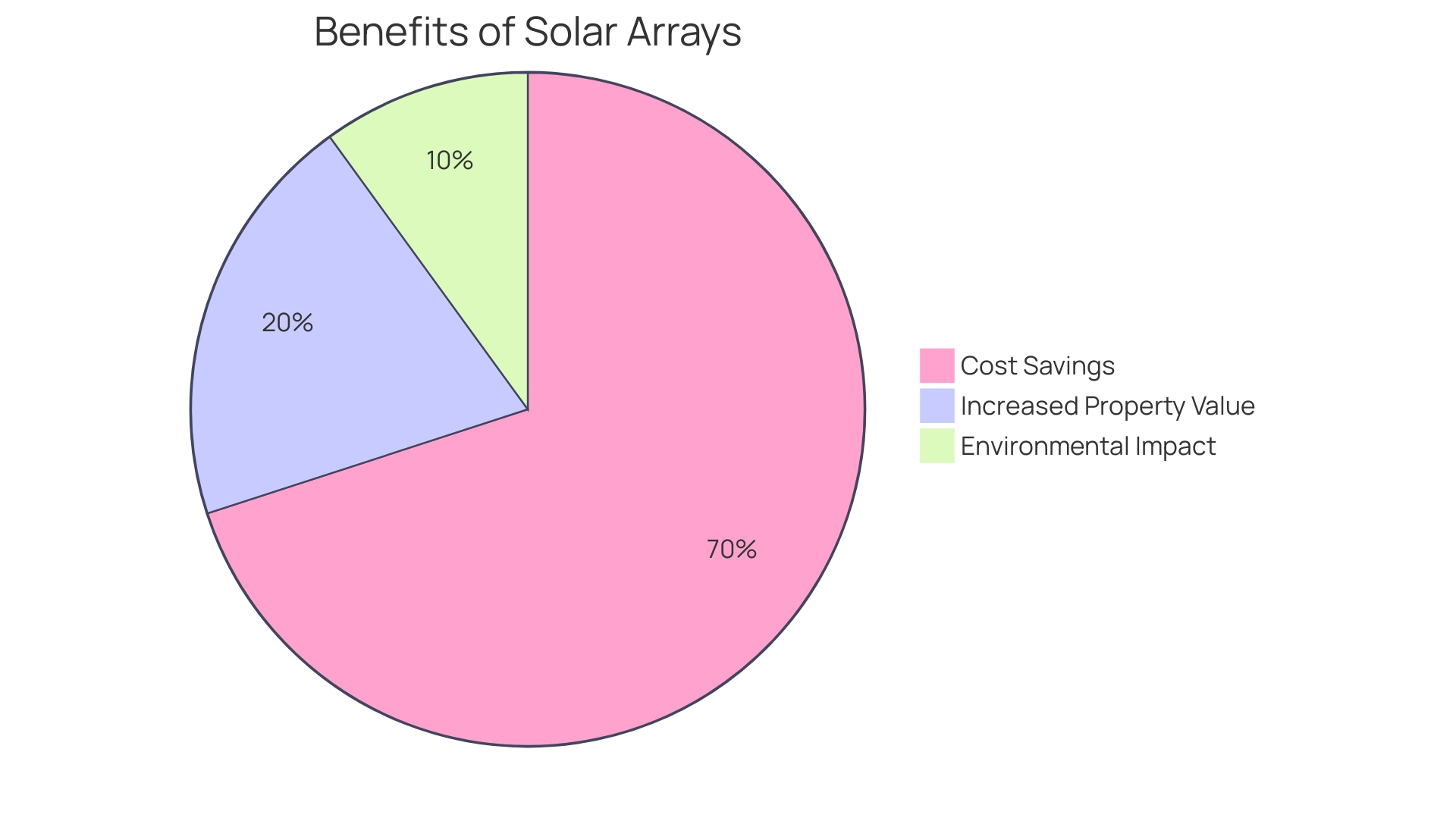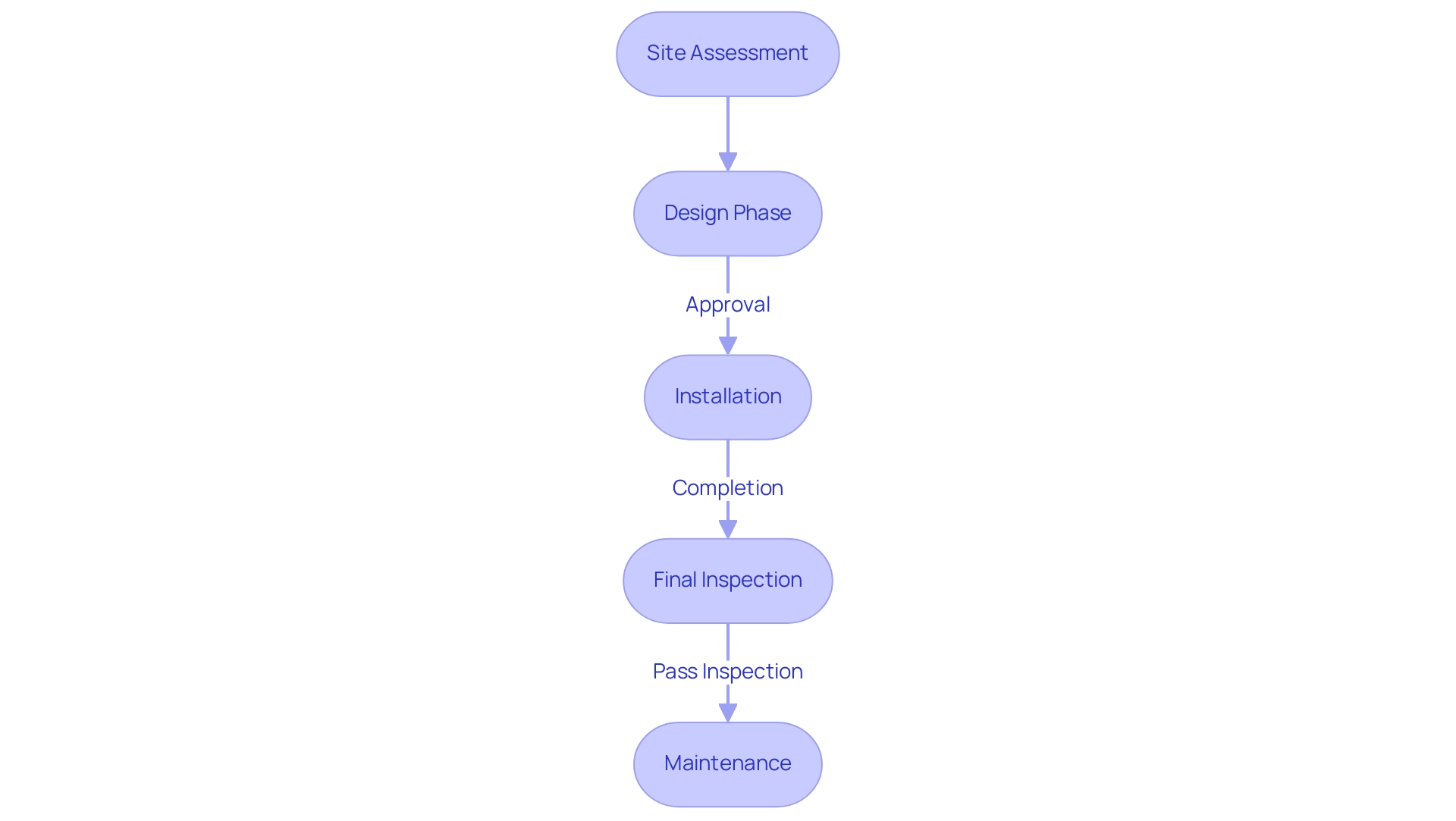Overview
The article provides a comprehensive overview of solar arrays, defining them as systems of photovoltaic modules designed to capture sunlight and convert it into electricity, essential for sustainable energy solutions. It details the components involved, the photovoltaic process, benefits such as cost savings and energy independence, and the installation process, supported by recent advancements and data indicating the growing adoption of solar technology among homeowners.
Introduction
In a world increasingly driven by the need for sustainable energy solutions, solar arrays have emerged as a beacon of hope for eco-conscious homeowners. These sophisticated systems, composed of multiple solar panels, harness the sun’s power to generate electricity, offering not only a pathway to energy independence but also significant financial benefits.
With advancements in technology and a growing commitment to reducing carbon footprints, the solar industry is witnessing unprecedented growth. As homeowners explore the myriad components and advantages of solar arrays, from the photovoltaic process to financial incentives, they are not just investing in their properties but also contributing to a greener future.
This article delves into the intricacies of solar arrays, illuminating their evolution, functionality, and the transformative benefits they offer in today’s energy landscape.
Understanding Solar Arrays: Definition and Components
The solar arrays definition refers to an extensive system of collectors engineered to capture sunlight and transform it into electricity, establishing it as a vital investment for environmentally aware homeowners. Each module is equipped with photovoltaic (PV) cells, crucial for generating electricity when exposed to sunlight. The solar arrays definition includes the main components of a photovoltaic array, such as:
- Photovoltaic modules
- Inverters
- Mounting systems
- Electrical connections
Typically made from high-efficiency silicon, solar devices convert sunlight into direct current (DC) electricity, which is then changed into alternating current (AC) by inverters, making it suitable for household use. The efficiency rating of these units often exceeds 20%, ensuring optimal energy production even on cloudy days. Mounting systems are essential for securely positioning the panels on roofs or ground installations, while electrical connections facilitate the efficient flow of generated electricity to the home’s electrical system.
Recent advancements in the renewable energy sector illustrate the growing adoption of this technology, with 1.1 GW of residential installations completed in Q3 2024, despite a 4% decline quarter-over-quarter. This indicates not only a transition towards sustainable energy but also underscores the financial advantages, including possible cost reductions for residents, which can amount to between $400 to $600 each year in utility expenses through renewable heating systems. The growth of the renewable energy sector is projected to create over 66,000 manufacturing jobs by the end of the decade, showcasing its potential impact on the economy.
Furthermore, as homeowners increasingly adopt alternative energy solutions, they contribute to the reduction of greenhouse gas emissions—estimated to be around 2 tons of carbon dioxide per household per year, equivalent to not operating a vehicle for four months. This comprehensive approach not only promotes sustainability but also highlights the long-term value of investing in renewable energy technology.
The Evolution of Solar Arrays: A Historical Perspective
The evolution of solar arrays definition traces back to the mid-20th century, marked by the invention of the first practical photovoltaic cell in 1954. Initially deployed in space missions, this groundbreaking technology gradually transitioned into residential and commercial applications. The crucial 1970s resource crisis sparked a rise of interest in renewable power solutions, resulting in heightened investments in photovoltaic technology.
Significantly, this period sparked the formation of multiple global partnerships, including:
- The IEA Photovoltaic Power Systems Technology Collaboration Program
- The International Solar Alliance
These partnerships focused on lowering expenses and increasing awareness of photovoltaic potential.
In California, recent improvements in construction regulations and the implementation of NEM 3.0 have altered the landscape of renewable power, providing property owners new opportunities under the 200% rule. For example, case studies have demonstrated that property owners who implemented photovoltaic systems, exemplifying the solar arrays definition, have significantly decreased their energy expenses while enhancing their property values. These advancements enable environmentally aware homeowners to optimize their efficiency based on the solar arrays definition and acquire knowledge about residential energy system sizing.
Moreover, advancements propelled by artificial intelligence are improving energy efficiency by optimizing the placement of photovoltaic structures to reduce shading problems, which is especially advantageous for properties in shaded regions of Santa Cruz. AI technologies examine sunlight patterns and modify panel angles accordingly, thus enhancing power capture and overall system performance.
As environmental awareness continues to rise, the journey of photovoltaic technology highlights its vital role in the shift to a sustainable power future. With a new renewable energy project installed every 39 seconds and major corporations like Amazon, Google, and Meta contracting over 25 gigawatts of capacity, the momentum is clear. However, obstacles such as disinformation and limited transmission capacity could hinder the growth of renewable solutions, making it essential for homeowners to stay informed about the benefits and insights of these alternatives.
Furthermore, blog posts covering the latest advancements in photovoltaic technology offer important perspectives on enhancing efficiency and maneuvering through the changing power landscape.
How Solar Arrays Work: The Photovoltaic Process Explained
The solar arrays definition explains how solar installations function according to the photovoltaic effect, where sunlight is absorbed by the photovoltaic (PV) cells within the arrays. As sunlight strikes these cells, it excites electrons, initiating a flow of electricity in the form of direct current (DC). This DC electricity is then routed to an inverter, which converts it into alternating current (AC) for compatibility with home appliances and the electrical grid.
Moreover, the solar arrays definition indicates that combining battery storage systems with photovoltaic arrays enables homeowners to retain excess power for later use, greatly improving autonomy and establishing a more sustainable power solution. The installation process begins with professional racking and mounting, where skilled installers securely attach the racking and mounting hardware to the roof, ensuring a durable foundation. Once the mounts are set, high-efficiency photovoltaic units are arranged as per the solar arrays definition to optimize power production.
Wiring methods are used to link the photovoltaic panels to a high-performance inverter, ensuring safe and efficient power flow. Finally, after obtaining local authority approvals, the energy system is commissioned and activated, transforming homes into eco-friendly powerhouses. Recent innovations in photovoltaic technology, including record lab efficiencies reported in 2023 by Fraunhofer ISE, underscore the ongoing advancements in the field.
With global photovoltaic investments exceeding USD 480 billion in 2023, the momentum for this energy source continues to grow. As Piotr Bojek, lead author of an IEA Special Report, notes, ‘By the end of this decade, photovoltaic energy is set to become the largest renewable source, surpassing both wind and hydropower.’ Additionally, the diversity in photovoltaic technology is illustrated by the case study on thin-film panels, which, despite an efficiency range of 10-13%, offer lightweight and flexible options suitable for portable applications.
This emphasizes the range of photovoltaic options accessible to property owners, paving the way for a future where such technology becomes the leading renewable power source.
Benefits of Solar Arrays: Cost Savings and Energy Independence
The transition to photovoltaic systems, as outlined in the solar arrays definition, offers a variety of advantages for property owners, mainly through significant savings on electricity expenses and increased energy autonomy. By generating their own power, residents can significantly reduce or even eliminate their monthly electricity expenses. Recent estimates suggest that the typical U.S. property owner could save around $50,000 over 25 years after installing photovoltaic panels, which aligns with the solar arrays definition, and the possibility for savings may exceed $100,000 when considering incentives such as net metering and local rebates.
Properties equipped with solar technology typically enjoy increased market attractiveness, often leading to higher property values, making them a wise investment for eco-conscious homeowners. As highlighted by Powercore Electric, a company recognized for its local expertise and unparalleled quality craftsmanship, sustainable solutions not only benefit your wallet but also contribute to environmental sustainability. For example, one pleased client mentioned, ‘Powercore Electric transformed my utility costs; I now save hundreds each month.’
The solar arrays definition highlights how investing in renewable sources decreases dependence on fossil fuels and reduces carbon emissions, aligning perfectly with the values of eco-conscious individuals. Furthermore, with supply chain disruptions easing and U.S. manufacturing increasing, the availability of photovoltaic modules is improving, which enhances market conditions for investments in renewable energy, particularly in relation to the solar arrays definition. A thorough comparison shows that property owners can anticipate saving approximately 70% on their utility bills after transitioning to photovoltaic systems, which is aligned with the solar arrays definition, in contrast to conventional electricity expenses.
Additionally, as the national community energy market is projected to grow at an average annual rate of 2% through 2026, the momentum towards renewable energy solutions continues to strengthen, making energy arrays a smart investment for the future.
Financial Considerations: Costs, Incentives, and Rebates for Solar Arrays
For eco-conscious homeowners in Long Beach, understanding photovoltaic systems is crucial to unlocking renewable energy’s potential. The solar arrays definition describes arrays that consist of multiple panels which convert sunlight into electricity, requiring a racking system to support and secure the panels in place. The initial investment for installing photovoltaic arrays, also known as solar arrays definition, generally ranges from $15,000 to $30,000, influenced by factors such as system size and complexity.
However, renters can significantly reduce costs through various incentives and rebates available. Federal tax credits allow property owners to deduct a significant portion of their installation expenses from taxable income, while state and local government rebates further promote renewable energy adoption. California boasts the lowest average installation costs, making it an attractive option for Long Beach residents.
According to ConsumerAffairs.com, installation costs per watt vary from $2.33 to $2.88, reflecting the diverse financial landscape of renewable energy projects. Furthermore, financing options such as energy loans and power purchase agreements (PPAs) offer pathways for homeowners to distribute costs over time, easing the initial burden. This financial support not only enhances the overall value of a property—typically increasing by about 4% post-installation—but also contributes to significant climate improvements, as emphasized by Chris Bolt:
- ‘Most importantly, though, you’ll be making a significant improvement on climate change and setting an example for your family, friends, and neighbors to follow.’
Moreover, incorporating Tesla home chargers and routine cleaning services for photovoltaic panels can enhance the effectiveness and lifespan of renewable power systems. By understanding these aspects, Long Beach renters can make informed decisions about accessing eco-friendly energy solutions.
The Installation Process: What Homeowners Need to Know
The process of installing solar arrays definition encompasses several essential steps designed to maximize efficiency and effectiveness. Initially, a thorough site assessment is performed to evaluate the home’s renewable energy potential, considering critical factors such as roof orientation, shading, and local climate conditions. This evaluation is essential as it establishes the foundation for a successful photovoltaic installation and assists property owners in understanding the solar arrays definition, identifying their specific energy requirements, and selecting ideal batteries for effective energy storage.
Following this, the design phase commences, where experts at Powercore Electric develop a customized renewable energy solution that aligns with the property owner’s energy needs, ensuring a sustainable approach that embodies the company’s dedication to serving both Northern and Southern California. Once the design receives homeowner approval, the installation team secures all necessary permits and schedules the installation date.
Typically, the installation itself takes between one to three days, depending on the complexity of the system and the existing infrastructure. As stated by industry experts, this timeframe allows for meticulous execution while maintaining quality standards.
In fact, 54% of installers anticipate selling more renewable energy systems in 2024 than they did in 2023, reflecting a positive outlook for the industry. Furthermore, BNEF forecasts an average growth of 6% per year from 2024 to 2030, underscoring the increasing demand for innovative energy solutions. After installation, a comprehensive final inspection is conducted to ensure that the system meets all safety and performance criteria before it is activated.
This careful approach not only guarantees the functionality of the solar arrays definition but also embodies the latest best practices in installation, which are continually evolving to enhance efficiency and sustainability. Routine upkeep is essential for durability, and property owners can investigate creative cleaning options like specialized energy system cleaning kits or professional cleaning services to maintain performance. Furthermore, comprehending the best methods for choosing panel inverters is vital; property owners should take into account aspects such as inverter efficiency, warranty, and compatibility with their system.
Additionally, understanding tax incentives related to renewable technology is important for individuals considering sustainable solutions from Powercore Electric. These credits can significantly improve the financial feasibility of renewable energy investments, enabling property owners to maximize their savings. China’s recent record-setting achievements in wind and photovoltaic installations serve as a motivational example for property owners considering renewable energy systems, showcasing successful practices and leadership in energy expansion.
Overcoming Challenges: Common Issues in Solar Array Installation
While the benefits of photovoltaic systems are compelling, environmentally aware residents often face various challenges during the installation process. Key issues include:
- Concerns about roof integrity
- Permitting delays
- Unforeseen expenses
It is essential for property owners to confirm that their roofs are structurally stable before moving forward with panel installation, as required roof repairs can result in considerable extra expenses.
Recent data highlights that 85% of installers utilizing NREL’s SolarAPP+ permitting software report that it simplifies the permitting process, indicating the value of collaborating with experienced installers who are familiar with local regulations. Furthermore, property owners should anticipate unexpected expenses that may arise from additional equipment needs or structural modifications. By proactively tackling these challenges, homeowners can enable a smoother shift to renewable energy.
Additionally, the 2024 report from SolarReviews highlights these concerns, noting that installers frequently encounter permitting issues and roof integrity challenges, which can complicate energy projects. Insights from energy professionals emphasize the importance of thorough planning and communication to effectively overcome installation hurdles. Furthermore, well-known renewable incentives among installers, such as statewide tax credits and storage rebates, can greatly assist property owners contemplating installation of solar panels.
The case study titled ‘How Property Owners Benefited from Household Energy Systems Under the 200% Rule’ illustrates practical examples of these advantages, while the tutorial on understanding residential panel sizes provides essential information for residents making informed decisions. The scale of solar energy adoption is exemplified by the fact that Amazon, Google, and Meta have a combined contracted pipeline of over 25 GW, highlighting the growing relevance and authority of solar energy in today’s market, and offering homeowners a promising path towards long-term sustainability and energy efficiency.
Conclusion
The journey through the world of solar arrays reveals a transformative approach to energy consumption and sustainability for homeowners. By understanding the components, historical evolution, and functioning of solar technology, individuals can appreciate the significant benefits that solar arrays offer. From substantial cost savings on electricity bills to increased property values and reduced carbon footprints, investing in solar energy is not just a financial decision but a commitment to a more sustainable future.
The advancements in solar technology, including innovations like artificial intelligence and improved photovoltaic efficiency, underscore the potential for homeowners to maximize their energy independence. The financial incentives available, such as federal tax credits and local rebates, further enhance the appeal of solar installations, making them a viable option for a growing number of eco-conscious individuals.
As the solar industry continues to expand, overcoming challenges like permitting and installation complexities will become increasingly manageable. Homeowners who navigate these hurdles can unlock the full potential of solar energy, transforming their homes into eco-friendly powerhouses. Ultimately, embracing solar arrays is a proactive step towards not only reducing energy costs but also contributing to a healthier planet for future generations. The momentum of solar energy adoption is clear, and the time for action is now.




